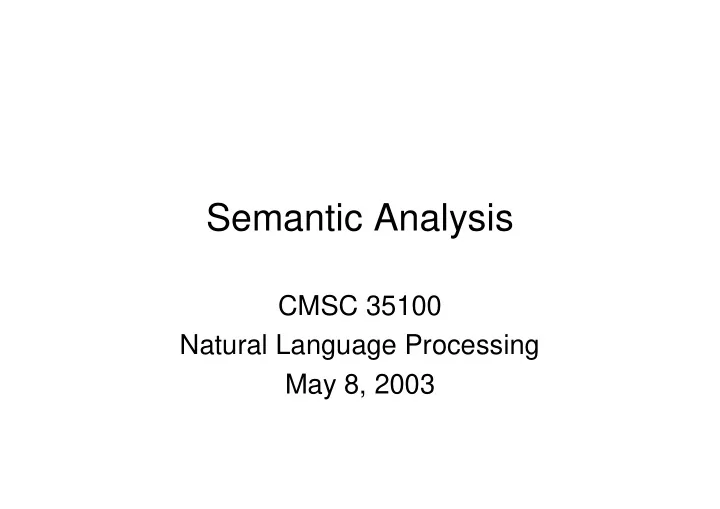

Semantic Analysis CMSC 35100 Natural Language Processing May 8, 2003
Roadmap • Semantic Analysis – Motivation: • Understanding commands – Approach I: Syntax-driven semantic analysis • Augment productions with semantic component – Lambda calculus formulation – Approach II: Semantic Grammar • Augment with domain-specific semantics – Approach III: Information Extraction • Template-based semantics
Understanding Commands • “What do I have on Thursday?” • Parse: S Q-Wh-obj Whwd Aux NP VP/NP Pron V NP/NP Temporal P NP N What do I have t on Thursday
Understanding Commands • Parser: – Yes, it’s a sentence & here’s the structure • System: Great! But what do I do? S Action: Check calendar Cal Owner: User Q-Wh-obj Date: Thursday Cal Date: Thursday Whwd Aux NP VP/NP Owner: User Date: Thursday Pron V NP/NP Temporal Cal Date: Thursday P NP Owner: User N Date: Thursday What do I have t on Thursday
Syntax-driven Semantic Analysis • Key: Principle of Compositionality – Meaning of sentence from meanings of parts • E.g. groupings and relations from syntax • Question: Integration? • Solution 1: Pipeline – Feed parse tree and sentence to semantic unit – Sub-Q: Ambiguity: • Approach: Keep all analyses, later stages will select
Simple Example • AyCaramba serves meat. ( , ) ( , ) ( , ) ∃ ∧ ∧ e Isa e Serving Server e AyCaramba Served e Meat S NP VP Prop-N V NP N AyCaramba serves meat.
Rule-to-Rule • Issue: – Need detailed information about sentence, parse tree • Infinitely many sentences & parse trees • Solution: – Tie semantics to finite components of grammar • E.g. rules & lexicon – Augment grammar rules with semantic info • Aka “attachments” – Specify how RHS elements compose to LHS
Semantic Attachments • Basic structure: – A-> a1….an {f(aj.sem,…ak.sem)} • Language for semantic attachments – Lambda calculus • Extends First Order Predicate Calculus (FOPC) with function application • Example (continued): – Nouns represented by constants • Prop-n -> AyCaramba {AyCaramba} • N -> meat {meat}
Semantic Attachment Example • Phrase semantics is function of SA of children – E.g. NP -> Prop-n {Prop-n.sem} – NP -> N {N.sem} • More complex functions are parameterized – E.g. Verb -> serves { ( , ) ( , ) ( , )} λ λ ∃ ∧ ∧ x y e Isa e Serving Server e y Served e x – VP -> Verb NP {V.sem(NP.sem)} λ ∃ ( , ) ∧ ( , ) ∧ ( , ) y e Isa e Serving Server e y Served e Meat • Application= – S -> NP VP • Application= ( , ) ( , ) ( , ) ∃ ∧ ∧ e Isa e Serving Server e AyCaramba Served e Meat
Complex Attachments • Complex terms: – Allow FOPC expressions to appear in otherwise illegal positions ∃ • E.g. Server(e, x Isa(x,Restaurant)) ∧ • Embed in angle brackets ∃ • Translates as x Isa(x,Restaurant) Server(e,x) – Connective depends on quantifier • Quantifier Scoping – Ambiguity: Every restaurant has a menu • Readings: all have a menu; all have same menu • Potentially O(n!) scopings (n=# quanifiers) – Solve ad-hoc fashion
Inventory of Attachments • S -> NP VP {DCL(VP.sem(NP.sem))} • S -> VP {IMP(VP.sem(DummyYou)} • S -> Aux NP VP {YNQ(VP.sem(NP.sem))} • S -> WhWord NP VP – {WHQ(NP.sem.var,VP.sem(NP.sem))} ∧ • Nom -> Noun Nom { λ x Nom.sem(x) NN(Noun.sem)} • PP -> P NP {P.sem(NP.sem)} ;; NP mod • PP -> P NP {NP.sem} ;; V arg PP • P -> on { λ y λ x On(x,y)} ∃ • Det -> a { } • Nom -> N { λ x Isa(x,N.sem)}
Earley Parsing with Semantics • Implement semantic analysis – In parallel with syntactic parsing • Enabled by compositional approach • Required modifications – Augment grammar rules with semantic field – Augment chart states with meaning expression – Completer computes semantics – e.g. unifies • Can also fail to unify – Blocks semantically invalid parses • Can impose extra work
Sidelight: Idioms • Not purely compositional – E.g. kick the bucket = die – tip of the iceberg = beginning • Handling: – Mix lexical items with constituents (word nps) – Create idiom-specific const. for productivity – Allow non-compositional semantic attachments • Extremely complex: e.g. metaphor
Approach II: Semantic Grammars • Issue: – Grammatical overkill • Constituents with little (no) contribution to meaning • Constituents so general that semantics are vacuous – Mismatch of locality • Components scattered around tree • Solution: Semantic Grammars – Developed for dialogue systems • Tied to domain • Exclude unnecessary elements
Semantic Grammar Example • What do I have on Thursday? – CalQ -> What Aux UserP have {on} DateP • Cal action:=find; CalOwner:= head UserP; Date:=head DateP; – UserP-> Pron • Head:=Head Pron – Pron-> I • Head:= USER – DateP -> Dayof Week • Head:= sem DayofWeek
Semantic Grammar Pros & Cons • Useful with ellipsis & anaphora – Restrict input by semantic class: e.g. DataP • Issues: – Limited reuse • Tied to application domain – Simple rules may overgenerate
Recommend
More recommend